PREPARATION
First you will need a prepared space to plant the hardwood cuttings. Each cutting should have an area which is 15cm / 6in apart from thenext cutting. If you have more than one row of cuttings, each row should be 25cm / 10in apart. If your soil is light, add some well-rotted compost. Dig the area with a fork to a spade’s depth.
This area for the cuttings will be occupied by the cuttings up untilmid-autumn the following year when they can be moved into their final positions.Choose an area which is protected from strong winds and preferably not in fullsun in the summer afternoon.
The cuttings will planted in a small trench and it’s best to cover the bottom of the trench with about 3cm / 1in of grit or sharp sand to help with drainage. You will need a sharp pair of secateurs which are clean.
Finally you will need some plant markers to show where the cuttings are planted, which variety they are and when you planted them. Don’t forget this, because you will plant your cuttings in autumn /winter and then you can forget about them (drought aside) until mid-autumn next year. That’s more than enough time for me to forget the variety name!
WHEN AND HOW TO TAKE ROSE HARDWOOD CUTTINGS
Take the cuttings any time between mid autumn and late winter. Different parts of the UK have very different weather conditions, take the cuttings when the leaves on the rose bush are starting to fall or have fallen completely in your area.
A typical hardwood cutting will be about 15cm / 6in to 20cm / 8in long. Itshould have a bud just above the lower cut and a bud just below the upper cut,see the picture below. We recommend making the upper cut slanting away from thebud. This will encourage any rain which falls on the upper surface to run offand avoid rotting the top bud. It also identifies the top of the stem from thebottom of the stem.
Rose bud
One stem can provide more than one hardwood cutting. For example, a stem of 40cm / 16in long can easily be cut to provide two suitable cuttings.
Prepared rose cutting ready for planting
Select only stems from this year’s growth which are healthy. Each stem should be roughly the width of a pencil or a biro. This year’s stems will be green, older stems will be browner in colour.
PLANTING THE ROSE HARDWOOD CUTTINGS
If you are not planting the cuttings immediately, place them, lower end down, in a jug of water filled with 8cm / 3in of water.
Trench with grit for rose cuttings
Dig a narrow trench about 8cm / 3in deep and fill the bottom 3cm / 1in withgrit or sharp sand to help with drainage. Place the cuttings in the trench so that 5cm / 2in of thecutting will remain above ground level when backfilled with soil. Cuttingsshould be about 15cm / 6in apart. Backfill with the dug soil and gently firmdown with your boots or hands.
Planted rose cuttings
If the soil is not damp, water it to settle cuttings in. Remember to place aplant marker to show where the cuttings are, the variety and date of planting.
CARING FOR ROSE HARDWOOD CUTTINGS
In normal circumstances, the only care required for hardwood
cuttings is to keep the area weeded. In the summer, if conditions are very dry, occasionally water them. If your soil is poor, a sprinkling of blood, fish and bone in May will help the cuttings to develop.
Examine the cuttings every month or so from April onwards. Cutting which are growing will have green stems and eventually form leaves. If any cuttings turn brown then they have failed and they should be removed. Expect about half the cuttings to succeed in rooting and growing on.
In 2020 we took five hardwood cuttings of the rose variety
Margaret Merril. Three of them were definitely showing signs of rooted growth in early April, see picture below of one of them.
Rose cutting showing success in rooting – April
The picture below shows one of the cuttings (same variety) which does not look so vigorous. However, it does have a green stem and a few leaves. We will leave it in place and reassess its health in early May.
Rose cutting in April, a possible failure
With rose cuttings grown on their own roots, it takes longer before you can transplant them to their final position compared to grafted roses. Normally rose cuttings will be ready to transplant to their final position two to three years after the cutting is taken. Much does depend on the variety of the rose cutting. Transplant in autumn / early winter.
Late November 2020 update – the successful Margaret Merril cutting is growing slowly but surely. It is now about 30cm / 1ft tall with foliage still remaining. I will update through 2021.
IS IT LEGAL TO PROPAGATE ROSES AT HOME?
This is my understanding of the law as at October 2019, if you have any doubts, check it out for yourself. The following page (click here) from the gov.uk pages states “Your rights last for 25 years (30 years for trees, vines or potato varieties)”.
As far as propagating roses for home use (and not for resale) is concerned, anyone can do it at any time. But the minute you intend to sell the propagated plants, then the 25 year rule is effective for plants which have Plant Breeder’s Rights.

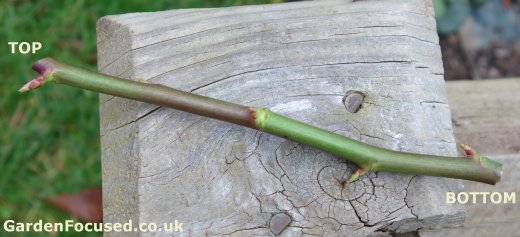
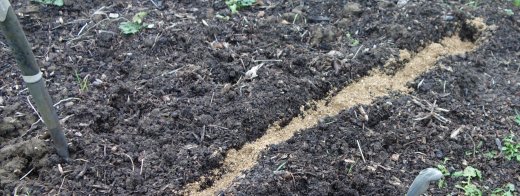
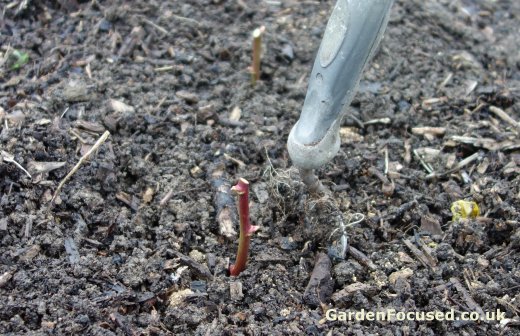
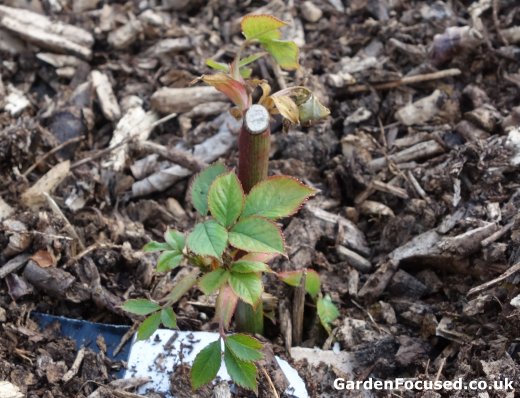
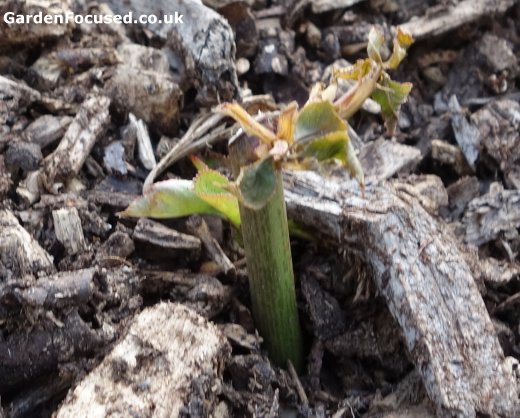
Recommended Rose Varieties for Small / Medium Gardens
Planting a Rose Bush
Caring for Rose Bushes
Prunining Rose Bushes
Propagating Rose Bushes from Hardwood Cuttings
Pests and Diseases of Rose Bushes
Comparison of online rose suppliers
ROSE PROPAGATION FROM HARDWOOD CUTTINGS
By David Marks
The two most popular methods for propagating roses are from seed or from cuttings. Forget growing roses from seed! It is a very specialist subject, takes years to do and is full of problems.
Cuttings are by far the easiest method. Taking hardwood cuttings in autumn and winter is also more likely to succeed by the amateur gardener compared to semi-hardwood cuttings in summer. This article is exclusively about taking hardwood cuttings in autumn and winter.